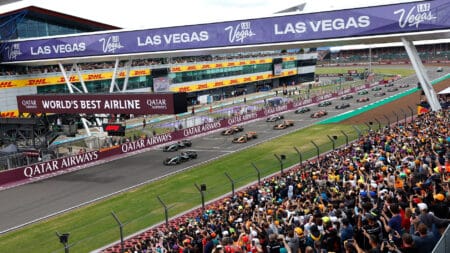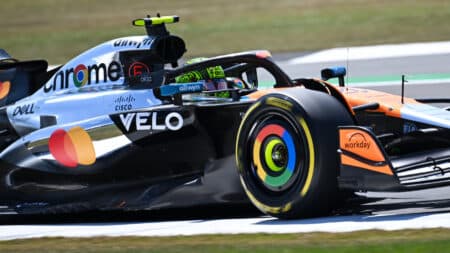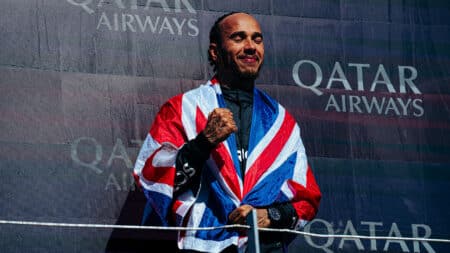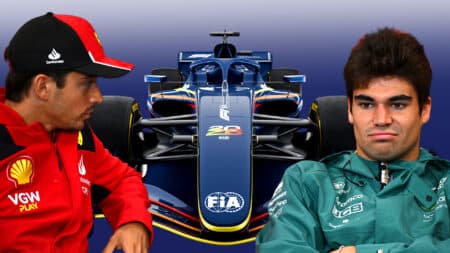
Tomorrow's F1 starting grid for the 2025 British Grand Prix
Max Verstappen will start on pole for the 2025 British Grand Prix after a brilliant last gasp qualifying lap. Here's how the starting grid looks for Sunday's race at Silverstone
Lewis Hamilton matches Jim Clark and Alain Prost with a controlled fifth British Grand Prix win
On the surface it was a Lewis Hamilton show in front of his home crowd, equalling Jim Clark in winning four consecutive British Grands Prix. From a dominant pole, it was a measured performance, keeping Kimi Räikkönen’s Ferrari just far enough off his back and then letting rip when he needed the gaps at the strategic times. A silver blur, a crowd-surfing hero. But the carnage in his wake, as the Ferraris burst their tyres in the closing stages, told of what was behind that performance.
There were concerns coming to Silverstone about the durability of the front-left Pirelli. The cars are five seconds faster than last year. Through Copse they are pulling 5.2g compared to 4.7 in 2016. Through the bumpy Chapel corner they were seeing speeds of 291km/h (less than 280 last year). “These cars are just monstrous around here. They’re like the ultimate rollercoaster ride,” Hamilton had said with a gleam in his eye after qualifying. Drivers were getting out buzzing with the sheer thrill of expressing their cars’ performance through the fast corners. Not only fast, but long-duration too. Around this clockwise circuit that meant there was a potential wear limit on the left-front.
The effect of that was to poise the race very delicately between a one- and two-stop. An early three-lap safety car (for the colliding Toro Rossos at Becketts) swayed it towards a one-stop, but that strategy carried with it the inherent risk of running into that front-left wear limitation.
If your position was established and wasn’t under any threat, and the cars in front too far away, you could afford to nurse the tyre. But if you were Ferrari – trying to a) hang onto Hamilton or b) fend off Valtteri Bottas on his transposed tyre strategy from his penalised grid place – then you couldn’t surrender, you just had to push up hard against that limitation, and then hope.
That gamble went bust for Räikkönen two laps from the end and for Sebastian Vettel a lap later. The Ferraris were just not quite as quick as the Mercedes W08 around here, especially that of Hamilton. Also, the respective traits of the two cars – how their lap times are derived – allowed the Merc to be easier on the fronts, and enabled the team to come into the race with an unambiguous one-stop plan. The Merc around these long turns had a balance that allowed Hamilton and Bottas to turn the car in late and have it simply follow its nose. The Ferraris, by contrast, tend to initially slide their fronts, then rely on a more suddenly rotating rear to turn the car. Around Silverstone, that wore out the fronts quicker than on the Merc.
With a car tougher on its fronts being pushed harder for longer than was feasible, Ferrari was pincered into an impossible dilemma by the combination of car and track traits, tyre durability and strategic necessity – and most of all by Hamilton’s raw pace and Bottas’ attacking pressure.
Hamilton at Silverstone – always fast, always a drama. Last year it was having his first Q3 run disallowed for track limit infringements. This time he faced a possible penalty for having got in the way of the end of Romain Grosjean’s lap at the beginning of his own final Q3 attempt. The usual penalty for this is three grid places, which would have had him starting fourth. The lap itself was faster than anyone else’s by the resounding margin of over half a second on this overcast, blustery, damp afternoon. No, he hadn’t impeded, said the stewards, he’d merely ‘effected’ Grosjean’s car. The distinction of this? It was judged that his car itself was not physically in the way, but that its aerodynamic wake did affect the Haas. This distinction dates back to Monza 2006 when Fernando Alonso was infamously penalised for having impeded Felipe Massa’s Ferrari even though the Renault was running about 200 metres in front. The aero wake did ‘effect’ Massa on that occasion but it was later agreed that this interpretation could not practically be considered impeding and the sporting regs were tweaked to prevent a repetition. Thus Hamilton’s 67th pole – one short of Schumacher’s all-time record – stood.
Silverstone was its usual capricious self on Saturday afternoon, gusty showers featuring prominently, and Q1 began with everyone on inters. Alonso played a beautiful cameo in this session by coming in near the end for a change to slicks. Making it over the line to begin the lap with less than half a second to spare, he went fastest – to the great approval of the crowd. It meant little in reality, for the McLaren was no more competitive here than anywhere else, but it was a magical little moment.
It was slicks all the way thereafter as the wind quickly dried the track, leaving just a few damp patches. The Mercedes W08 was in its element around the fast sweeps and Hamilton was delighting in this generation of car around a track that could have been created for it. “The downforce is incredible,” he said. “One of the reasons why this track is so great is that we always generally have into Copse a headwind. So it’s like being in a wind tunnel with just the optimum downforce package. Copse… obviously we were building up to it because it was a little bit damp at the beginning. You can take it flat in eighth but it’s not necessarily that quick, you scrub quite a lot of speed off and then the rpm potentially would drop a little bit too much, so I don’t personally do it flat and it didn’t seem to cost me any time. And then when you come through Maggotts and Becketts, that section is just on fire; you just can’t imagine how incredible it is when you come through 10, 11… Ten is obviously always flat, 11 has been flat for years, 12, from 2007 to now, just bit by bit, you’re letting off later and later and now you’re kind of still on the gas through 12, or into 12 at least. And then 13 is a fantastic corner because it’s very bumpy through there. You’ve got maximum downforce, a lot of compression on the tyres and it’s all about the exit. And then obviously coming down to Stowe, where you’re turning already as you start to brake and you’re trail-braking all the way in. You only dab the brake and you’re straight back on the gas. It’s unbelievable!”
So long as Hamilton hooked the lap together no one else was going to take pole – and his margin over the Ferrari of second-fastest Kimi Räikkönen was more than half a second. A statistical nicety was that the Hamilton-Räikkönen front row was the same as that here 10 years earlier, marking the biggest time passage between identical front rows at the same race.
Both the Mercedes and Ferrari featured significant engine upgrades here, but the Merc’s advantage seemed to come mainly through the high-speed sections – but not necessarily through a grip advantage, as Vettel pointed out. “We were 10kph quicker than the Merc through Copse in qualifying. But with these cars there are now more corners here that are not grip-limited, where you just go through flat and they have a very aero-efficient car, I think.”
Valtteri Bottas was compromised just as Hamilton had been in Austria with a replacement gearbox penalty and so had gone through Q2 on the soft (rather than the super-soft) tyre to give him a different race day strategy. So he was not in tune with the car’s balance when he got onto the super-softs on the changeable track. He was only fourth fastest, almost 0.8sec adrift of Hamilton.
Räikkönen is always very much at home through Silverstone’s sweeps and was satisfied with his lap but, like team-mate Sebastian Vettel, acknowledged that Hamilton’s time was simply out of reach. Vettel was irritated with his team for where they’d released him into the traffic on his final out lap, meaning his tyres weren’t fully prepared to begin the lap. He was third, a couple of tenths adrift of Räikkönen.
The Renault engine still doesn’t have anything like the extra performance mode of the Mercedes and Ferrari so over a qualifying lap they were nowhere, with Max Verstappen’s fifth-fastest time 1.5sec adrift of pole. Daniel Ricciardo’s car broke a turbo in Q1 and had to be abandoned, leaving him at the back. The engine and several components, including the turbo, were replaced but the fitment of a new ERS-h took him past the permitted four per season, incurring a meaningless 10-place penalty.
Nico Hülkenberg was enjoying both the enhanced grip of the Renault R.S.17’s new floor and the changeable conditions and after going fifth quickest in Q2, proceeded to qualify sixth in Q3, albeit 0.7sec off the Red Bull. Progress is being made at Enstone, but it’s early days yet. Jolyon Palmer, with the old floor, only just failed to make it into Q3, 11th fastest, 0.7sec off his team-mate.
Closely matched to the Renault, the heavily upgraded Force Indias of Sergio Pérez and Esteban Ocon went seventh and eighth, as ever a tiny gap between them, but with Pérez just ahead, as usual. The compromised Grosjean would’ve been eighth, Haas reckoned, but for being slowed by Hamilton. As it was he was 10th, one place behind Stoffel Vandoorne’s McLaren who made it through to Q3 partly thanks to team-mate Alonso being sent out in traffic. Fernando ended up 13th but would be taking the usual Honda penalties (30 of them) and therefore starting at the very back.
The Toro Rossos are not the most aerodynamically efficient of cars and were never Q3 contenders, Daniil Kvyat and Carlos Sainz going 12th and 14th respectively. Having featured in the top 10 all through the practices, Felipe Massa was unable to string a good lap together in the windy, cool conditions of qualifying and was only 15th. In the other car Lance Stroll struggled with his first wet qualifying session and at such a high-speed track. He was unable to progress from Q1, 16th, 0.6sec off Massa.
Kevin Magnussen was struggling badly, only 17th in his Haas, consistently half a second adrift of his team-mate for reasons he didn’t readily understand. He was barely faster than the Saubers of Pascal Wehrlein and Marcus Ericsson.
The original race start was aborted, everyone sent on their way again after Palmer had to pull the Renault off on Hangar Straight with no hydraulic pressure.
Brakes were afire as the cars sat on the grid, the drivers desperately trying to get heat into the tyres from the brakes and through the hubs. The rears of Vettel’s car were actually ablaze and as the lights went out he was slow away as the hot brakes were initially binding. Hamilton was unchallenged from Räikkönen into Abbey. Verstappen was trying to take advantage of Vettel’s difficulties and dived for the inside, getting briefly ahead but as his momentum was checked by Räikkönen as they came out of there, Vettel was able to run around his outside on the run down to Village. That looked to be that, but Verstappen never surrenders and as Vettel went in there on Räikkönen’s tail, so that slightest check to his speed allowed the Red Bull driver to go for the outside all around the Loop, cutting across the Ferrari before they entered Wellington Straight. Now stuck behind a slower car, a crucial part of Vettel’s fate had just been decided.
Ocon had snaked off the line to slot between Hülkenberg and Pérez with just an inch or two to spare to run fifth, but later in the lap Hulk was able to slipstream him down Hangar and put a committed move around the outside of Stowe. It was the foundation of an excellent drive from Hulk. Bottas on his soft tyres was running in this company initially, getting around Pérez’s outside at Village.
Sainz had passed team-mate Kvyat around the outside of Copse (180mph+!), but running wide onto the kerb there lost him momentum, allowing Kvyat to come back at him and they ran side by side through the kink of Maggotts, flat in top gear. Through the right-hander of Becketts, Kvyat ran out wide beyond the exit kerb, his left-rear brushing the dusty grass. Barely lifting and still fighting for the place, Kvyat oversteered as he rejoined the track, the rear sliding straight into the side of Sainz’s car, spinning him around over the grass and across the track, with Magnussen’s Haas taking a glancing blow on the way. Kvyat’s car was heavily damaged, Sainz’s was immobile and the safety car was deployed. Kvyat was later awarded a drive-through for how he’d rejoined the track. A bad day for Toro Rosso.
Hamilton was unchallenged on the restart at the end of the fourth lap and proceeded to pull out a couple of seconds margin over Räikkönen who quickly pulled out a sizeable gap to Verstappen, around whom Vettel could find no way by, not even after DRS has been enabled. Had it not been for Verstappen’s tenacity and the Ferraris had been running second and third, they might have been in a position to have applied strategic pressure on Hamilton. But maybe not – Hamilton looked to have pace in hand and could surely have eaten into it to get whatever gaps would’ve been required. Räikkönen was running out wider through the slow turns – notably Brooklands – than Hamilton, the Ferrari just not responding as instantly, scrubbing its front tyres across the surface for longer.
Bottas put a slipstreaming move on Ocon down to Stowe on the fifth lap to go sixth, and with Hülkenberg next in his sights Valtteri repeated the Stowe move two laps later. Ricciardo, meanwhile, had made good initial progress from the back row but ran wide out of Luffield and dropped briefly behind Alonso before doing it all over again, the Red Bull a shark among minnows, Daniel enjoying himself. Alonso had made short work of the Saubers and Magnussen but couldn’t progress past Stroll’s Williams before the Honda suffered a loss of fuel pressure 32 laps in.
The super-softs that all the front-runners bar Bottas were on were reckoned good for 25 laps and ideally you’d need to go that long to make a one-stop a comfortable strategy. But any undercut pressure might pull you in earlier than that. Ferrari began thinking of bringing Vettel in early to undercut Verstappen. Seb had got alongside the Red Bull into Stowe on the 13th lap but Verstappen held firm around the outside, even running off track, to reclaim the place to great cheers from the crowd. Vettel tried again the following lap, to no avail, and this time he was complaining that Verstappen was moving in the braking zone. It was a very subtle movement, but alarming all the same from the cockpit of the Ferrari at 200mph+ and a big closing speed differential.
The pair were now almost 10sec behind Räikkönen, who in turn trailed Hamilton by over 4sec. Räikkönen had been much closer than that but as the pitstop windows began to open, Lewis stepped up the pace to keep himself out of immediate undercut reach. It was a supremely controlled drive.
Having cleared the necessary gap to the Force Indias, Ferrari pulled the undercut peg with Vettel on the 18th lap – which was aggressively early if you were planning to one-stop and make your front-left last the remaining 33 laps. He was switched to the softs and underway again after 2.9sec – and setting a very hot pace on his out lap as Verstappen summoned as much as he could from his old super-softs for his in-lap as Red Bull responded. A sticking wheel-nut on the left-rear cost around half a second – and this probably cost him the place, as he emerged now behind the faster Ferrari. Both Vettel and Verstappen had an interesting challenge ahead now in trying to combine good pace with keeping their left-front softs in shape. The soft was actually more prone to blistering than the super-soft as its lower initial wear-rate meant more tread depth to retain heat.
Räikkönen had fallen to 10sec behind Hamilton by the time he was brought in on the 24th lap, with Hamilton in the next time around under no pressure whatsoever. Hamilton emerged just in front of his yet-to-stop team-mate Bottas – on his transposed tyre strategy – and quickly pulled away, thereby not compromising Valtteri’s efforts in running long to make up time on the Ferraris and Verstappen. He stayed out until the 32nd lap and was fitted with his super-softs. The fact that he’d completed a 32-lap stint on the softs at a good pace in a heavily-fuelled car tells you how much easier the Merc was on the front tyres than the Ferraris would be. This was a crucially important and super-impressive stint from Bottas. In forcing the Ferraris to up their pace so as to remain more than a pitstop gap ahead of him, he’d essentially forced them into tyre-destroying territory.
The degradation rate of the tyres around Silverstone was quite unusual in its pattern. It would initially be quick, go through a slow middle phase, then come back before finally running out of tread and becoming super-slow. If you pushed too hard on the tyre’s slow middle phase it created serious blistering. This then accelerates the wear rate, running you out of rubber faster. In keeping Bottas behind them during the tyre’s slow middle phase, they’d pushed the tyre irreparably far. “The car was so good to drive today,” related Bottas. “Through the quick corners it was amazing.”
Bottas had comfortably overcut Verstappen, who was struggling with his fronts already. Valtteri now began to chase down Vettel, whose softs were suffering. Vettel had been closing for a time on Räikkönen but Kimi, on his fresher tyres, had responded and pulled away – a knock-on effect of Bottas having put the pressure on Vettel.
Ricciardo had also pitted after a 32-lap stint – on the super-softs. That he’d made the softest tyre last this long while pulling overtake after overtake just emphasised once again the subtle brilliance of this driver. He exited just behind the dicing Force Indias, Ocon still ahead but holding up Pérez. Ricciardo sliced past the Mexican at the favoured passing place of Stowe at the end of the second DRS zone, a lap later he repeated the move to pass Ocon. Some way up ahead was Hülkenberg’s Renault, but with plenty of laps left, sixth place was now Ricciardo’s target. Ricciardo’s case was aided by Hülkenberg suffering a progressive decrease in power as a leaking exhaust caused the ers-H to operate less effectively.
Hamilton radioed in after 11 laps on his softs that the fronts had blistered, but he had comfortably enough margin to be able to nurse them, his lead over Räikkönen out to over 12sec with 15 laps to go. Bottas, meanwhile, was closing fast now on Vettel and on the 43rd lap tried an outside pass into Stowe. Vettel fought fiercely, hanging the Merc out wide over the kerbs, Bottas aggressively cutting back onto track and pressuring the Ferrari up to Vale. Vettel braked late but the worn fronts locked up in protest, thereby just further ensuring their doomed fate. On the next lap Bottas got the run going much earlier and did a simple DRS pass down Hangar Straight. Räikkönen’s second place was 10sec ahead – “minimal talking, please”, said Bottas – and there were eight laps to go. He probably wasn’t going to quite catch him.
“I have no more fronts,” said Vettel over the radio. The tread had worn out almost completely. Next is the carcass and eventually it all begins to delaminate. It was coming. Vettel held on as best he could, around 1.5sec off the pace, but these were old, much abused tyres. Verstappen – who was also struggling with his fronts, but less so – began to catch him, albeit from a long way back.
On the 48th lap, three from the end, Räikkönen’s front left delaminated just before he reached Copse. It remained inflated, but the tread was flapping around as he limped back to the pits. Bottas cruised by, putting the Mercs 1-2. His hard, consistent drive from his penalised slot had been a crucial part of making Ferrari’s gamble bust.
A lap later and Vettel was running off track at Luffield, his left-front flat. Forced to run a much slower pace to the pits than Räikkönen, he lost many places. Whereas Räikkönen was able to rejoin still third – and Verstappen made a precautionary change on the same lap, without losing his fourth place – Vettel was way back in seventh as he came out for the last lap, the last man not to be lapped by the victorious Hamilton. Amid all the drama, Ricciardo slipped by Hülkenberg at Stowe.
In the green room, the two Mercedes drivers compared notes and agreed how awesome their cars had been. A red-overalled, red-faced Räikkönen sat slumped, dejected. Verstappen had maximised a Red Bull that just didn’t have the slow corner performance expected, Ricciardo was just one place behind from the last row, Hülkenberg a deserving sixth for Renault. Behind Vettel, Ocon remained ahead of Pérez, all based on that storming start and Felipe Massa’s Williams prevailed over Stoffel Vandoorne’s McLaren for the final point only after the latter suffered a delay at his pit stop.
The five-time British Grand Prix winner went for a spot of crowd-surfing and now lies just one point behind Vettel.

Max Verstappen will start on pole for the 2025 British Grand Prix after a brilliant last gasp qualifying lap. Here's how the starting grid looks for Sunday's race at Silverstone

Austrian GP winner Norris went quickest at Silverstone during the Friday F1 practice sessions ahead of the 2025 British Grand Prix

Lewis Hamilton hadn't won in almost three years – and then produced a sensational victory at Silverstone 2024. James Elson explains why it was his best ever

As more drivers get a feel for the 2026 Formula 1 cars in simulators, concern is growing that the new regulations may sacrifice driving enjoyment in pursuit of technical ambition, as Mark Hughes reports